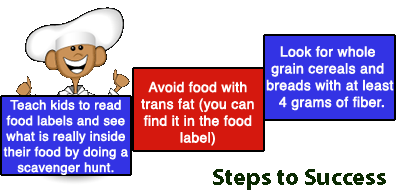
After reviewing the parts of the food label, take our Food Label Quiz
2 Calories
3 Daily Value
4 Fat
5 Cholesterol & Sodium
6 Carbohydrates
7 Fiber
8 Protein
9 Vitamins & Minerals
Serving size is the amount of food in one serving and servings per container is the number of servings in a package of food.
Serving sizes are usually consistent with similar types of foods, such as milk. Common household measurements are used to make it easier to compare similar foods, for example, apple juice is measured in cups. If a serving size is ½ cup, and your child drinks 1 cup, your child is getting twice the calories, fat and other nutrients on the label.
Encourage your child to use the Nutrition Facts label as part of maintaining a healthy diet. Many products have more than one serving and it can be easy for children to consume multiple servings and eat or drink more than he/she realizes.
This is the number of calories in one serving and the number of calories that come from fat in one serving.
Pay attention to the amount of calories and calories from fat if you are concerned about your child’s weight. This part of the label can help you manage your child’s weight whether he/she needs to gain, lose, or maintain. If your child consumes more calories than his/her body uses, your child will gain weight.
The percent Daily Value (% DV) provides the percent of nutrients in a serving of food based on the recommended daily allowance for adults. Remember when looking at the % DV that it is for the entire day not just for one meal or snack.
The * at the bottom of the Nutrition Facts food label is a reminder that the % DV is based on a 2,000 calorie diet. Children may need more or less of certain nutrients, depending on their gender and age.
There is no need to memorize the % DV, just use these guidelines when you are comparing labels:
The total fat is the number of fat grams in one serving. There are different kinds of fat including saturated, unsaturated and trans fat. While fats and oils are part of a healthful diet and essential for growing children, eating too much fat can be harmful to your child’s body. To help reduce their risk of heart disease, choose foods that are lowest in trans fat and saturated fat.
These numbers tell you how much cholesterol and sodium (salt) is in one serving of food. Eating less of these nutrients helps your child reduce their risk for high blood pressure and high cholesterol. Most of the sodium that children consume comes from processed foods and not the salt shaker.
Sugar and dietary fiber are types of carbohydrates. Sugar is an important part of the label if you are concerned with your child’s weight. There is not a percent daily value (%DV) for sugar. Use the Nutrition Facts label to compare the amount of grams of sugar in similar products and try to limit the foods with added sugars which add calories but not other nutrients. Look at the ingredients list for added sugar such as sucrose, glucose, fructose, or corn syrup.
A diet rich in fruits, vegetables and whole grains that contain fiber will help reduce your child’s risk of heart disease and improve their digestive tract.
Protein is very important because it is the fundamental building blocks for all cells. High protein foods can be high in fat. Compare foods to find foods that are high in protein but low in fat.
Most American children don’t get enough Vitamins A and C, iron and calcium, so choose the foods with the higher %DV for these nutrients. Eating enough of these nutrients can improve your child’s health and reduce their risk of certain diseases.

0 Comments